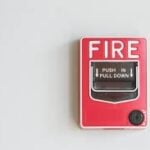When you are a large company or business that uses flammable liquids, there are specific requirements, codes, and permits that will apply. These flammable liquid permits need to be a part of any documentation that is kept in the office or warehouse. In order to run a business where flammable liquids are a part of the production process, knowing definitions and codes that will enable them to run is essential.
According to the National Fire Protection Association (NFPA), flammable liquids include liquids with a flash point of 100° F when they are tested using the closed-cup method. The NFPA identifies a total of six different classes that flammable liquids can fall into. Liquids in Class I are broken down further into Class IA, Class IB, and Class IC. There are also Class II liquids, Class IIIA, and Class IIIB liquids.
Flammable liquids include ethylene oxide, motor and aviation gasoline, some paints, paint thinners, and cooking oils. The higher the class, the more flammable the liquid will be. This means that any liquid in Class IA will be the most flammable. As a business owner with operational warehouses, it is important to know what class your flammable liquids fall into, because each have different severities and necessary permit requirements.
Operational Permits
If your business uses any of these flammable liquids in the warehouse, then you will need to obtain flammable liquid permits. One way that you will be covered with flammable liquid permits is through operational permits. An operational permit is required if the warehouse is going to be using and transporting flammable liquids. Flammable liquid permits are included in the operational permits when the business is going to be handling the flammable liquids inside the building and also directly outside of the building.
The operational permit is required when Class II or IIIA is going to be contained in excessive amount in an outside storage unit. Another requirement for this permit is if your business is going to operate vehicles, terminals, and equipment in the same building where the flammable liquids will be used, processed, and transported. The reason why flammable liquid permits are included under the operational permits umbrella is because flammable liquids require some type of transportation or operation.
How to Get a Permit
When it is time to get an operational permit that includes the flammable liquids permits, it is important to be aware that the permit requirements are different for each county. For each county, there will be a list of the requirements available on the county website. These websites will give you the minimum storage requirements for the flammable liquids.
One example of a minimum requirement is that all areas that are subject to heating are clear of flammable liquids. A second requirement is that there have to be flammable signs around all the areas that contain the flammable liquids. Another requirement is that there has to be a fire extinguisher within a certain number of feet of the flammable liquids. These are just a few examples of the requirements that will be on the county websites.
Once all of these items have been checked off the list provided, there will be site inspections, personnel trainings, and a review of the necessary documentation. There will also be a fee that will be changed for obtaining the permit. With a consultant like Compliance First, gathering the information needed for flammable liquids permits will be simple and easy. There can be a lot of information available about flammable liquids, and utilizing a consultant to aid in the process will help to narrow down what specifically you need for your business and the warehouses.











